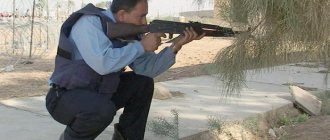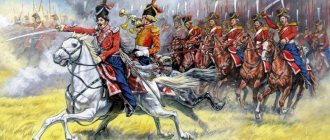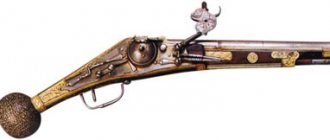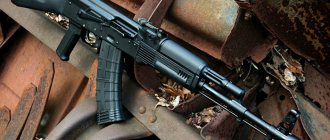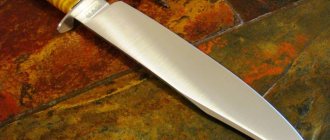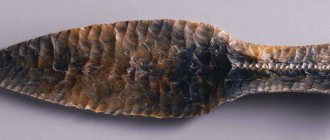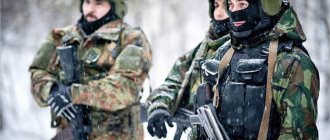Special forces TsSN FSB "Alpha"
Alpha Group
or
Directorate “A” of the TsSN FSB
- a special unit of the Federal Security Service of Russia, intended mainly for the release of hostages and anti-terrorist operations.
The content of the article
general information
Formed by order of the Chairman of the KGB Yu.V. Andropov in 1974 as a response to the terrorist attack at the Munich Olympics. Initially, it was a group of 30 people, subordinate first to the 5th and then to the 7th Main Directorate of the KGB. Currently subordinate to the Special Purpose Center of the FSB of Russia; special forces with the same name for a similar purpose are available in Belarus, Kazakhstan and Ukraine. The exact composition and size of the Alpha group is strictly classified.
Preparation of TsSN FSB "Alpha"
Initially, the Alpha group was staffed exclusively by officers and warrant officers (the latter are about 3% of the number, they occupy mainly auxiliary positions, for example, instructors). The age limit for candidates is 28 years (for those who came from other special forces, there is no this limit). There is also one serious physical limitation for candidates - height must be at least 175 centimeters. This is due to the fact that during operations, employees often use heavy armored shields of impressive dimensions. For short employees, these protective equipment simply drag on the ground.
Physical fitness requirements:
- Running 100 meters in 12 seconds;
- Running 3000 meters in 10.5 minutes;
- Pull-ups on the bar - 25 times;
- Torso bending - 90 times in 2 minutes;
- Push-ups from the floor - 90 times;
- Push-ups on parallel bars - 30 times.
- Complex strength exercise (15 push-ups, 15 flexions and extensions of the torso (testing the abdominals), then 15 times moving from the “crouched” position to the “lying position” and back, then 15 jumps from the “crouched” position up) - 7 once in a row.
The candidate is further required to pass a hand-to-hand combat test (stand for 3 minutes against a trained employee or instructor).
Candidates undergo special screening and psychological testing. The consent of the candidate's parents and spouse is mandatory for enrollment in Alpha. Those who successfully pass all these stages of selection are enlisted in the special forces, receiving black berets and Anti-Terror knives, after which they leave for their groups, where they undergo training in their specialty for 3 years.
Combat Operations Alpha
The first of Alpha's most high-profile operations was the storming of the palace of the Afghan dictator Kh. Amin on December 27, 1979. 24 special forces officers were part of the combined assault group together with the Zenit and Cascade groups. "Alpha" operated in Afghanistan throughout the armed conflict, performing tasks of anti-sabotage protection of Kabul and the direct protection of the Soviet embassy.
One of the types of tasks that only Alpha successfully handled in the USSR was the release of planes hijacked by terrorists, which happened very often in the 1980s. This special unit was also involved in the release of hostages when they turned out to be children. The last most high-profile success of “Alpha” was a joint assault with the “Vityaz” group on a pre-trial detention center seized by criminals in Sukhumi on August 11-15, 1990.
After the collapse of the USSR, Alpha came under the jurisdiction of the Special Purpose Center of the FSB of Russia. It was she who was involved in the release of hostages in Budyonnovsk, the theater on Dubrovka and Beslan. Also, Alpha officers serve on a permanent basis in Chechnya, where they are engaged in the capture and destruction of particularly important leaders of the terrorist underground.
Armament and equipment
At the time of the creation of the Alpha group, there were practically no specialized anti-terror weapons in the Soviet Union. The main weapons of the special forces were a Kalashnikov assault rifle with a silencer, Makarov and Stechkin pistols, a Dragunov sniper rifle and edged weapons. There simply were no compact rapid-fire weapons, most suitable for combat at a very short distance. Nevertheless, the unit, even with weapons that were not very suitable for this, successfully freed hostages, including those captured on airplanes.
The situation with weapons began to change by the beginning of the 1980s, when the AS “Val” assault rifle and the “Vintorez” sniper rifle, developed according to the joint requirements of the KGB and the Ministry of Defense, entered service. They were much better suited for anti-terrorist operations in urban environments, since a heavy 9-mm bullet, when hitting a target, transferred all the energy to the tissues of the human body, while piercing almost any body armor.
Alpha officers were also the first to receive the Grach and Gyurza pistols, loaded with reinforced cartridges capable of penetrating body armor. New models of submachine guns were also primarily adopted by this special forces unit.
Due to the need to fight in urban environments, FSB special forces are equipped with heavy body armor and titanium helmets.
Source
Jeep and rocket killers
The Americans were the first to develop modern heavy sniper rifles for destroying “hard” targets. In 1983, the US military purchased a batch of 12.7 mm M500 rifles from Research Armaments Prototypes (RAP) - they were used in Lebanon, Panama, Haiti and Iraq. Allegedly, as a result of Desert Storm, they even began to create special sniper groups with “anti-material” rifles to destroy missile launchers.
Our first large-caliber self-loading sniper rifle OSV-96 chambered for 12.7x108 millimeters from the Tula Instrument Design Bureau (KBP) appeared in the mid-90s. In 2000, the Kovrov plant named after Degtyarev (ZiD) made its bullpup version of the KSVK. And in 2004, the Kovrov team presented an improved version called ASVK (large-caliber army sniper rifle).
Large-caliber sniper rifle ASVK
Photo: Evgeny Biyatov / RIA Novosti
The main purpose of heavy “snipers” is to fight other snipers (a powerful cartridge can penetrate the wall behind which the shooter is hiding), destroying firing points and light armored vehicles - jeeps, armored personnel carriers, etc.
The technical specifications state that 12.7 mm rifles can make ultra-long shots of one and a half kilometers and with more special sniper cartridges. With an ideal accuracy of 1MOA at a distance of 1500 meters, the dispersion is just over 40 centimeters - this was pointed out by weapons historian Maxim Popenker. Foreign sources indicate that when using armor-piercing machine gun cartridges at a range of 1500 yards (about 1300 meters), the bullets fit into a rectangle of 3x6 meters. This allows, at best, to shoot at equipment, but not at individual people.
In addition, an ultra-long shot from a rifle is spectacular, but not effective. Military experts note that other types of weapons are more suitable for hitting distant targets.
How to get into the federal security service?
Selection for special forces units is quite difficult. This is due to the high load that the fighter will endure in the future, when he is included in the active group. It should be noted that advertisements for the FSB special forces recruitment cannot be found in print media or online resources.
Management selects candidates independently from among the current employees of the structure. It is not uncommon for proposals to be made to civilians.
First of all, the candidate must have a “clean” biography. That is, he cannot not only have a criminal record, but also should not be involved in criminal cases as a suspect or brought to administrative responsibility. This applies to his relatives and family members. If any of these persons have had problems with the law, the applicant's candidacy will not be considered.
Next, the person is checked against all databases. He should not be registered with the police department, narcologist or psychiatrist. In addition, the applicant must be completely healthy. To do this, he undergoes several medical commissions, which are carried out in the most thorough manner.
Physiological requirements are also imposed on the applicant. He must not be shorter than 176 centimeters and not older than 28 years . In addition, recommendations will be required from two employees who served in the FSB special forces.
Another prerequisite is the presence of a rank or title in any sport. Preference is given to candidates who have trained in martial arts, shooting or all-around. Having a higher education would also be helpful.
Employee uniform
Employees of the FSB special forces, in material and technical terms, are provided quite well. Uniforms are no exception in this case. The fighters are provided with it for both the summer and winter periods. Completeness is determined by the purpose of the form. It comes in three types - field, everyday and formal. The actual purpose follows from the name.
Field uniform - used when performing combat missions, casual uniform - for daily use, dress uniform - for special occasions.
Most often, fighters use field uniforms. It has a camouflage color and performs deforming and imitation functions. The first creates the effect of distorting the silhouette, the second allows you to merge with the environment. All this misleads the enemy.
The field uniform must meet the following requirements:
- match the color often found in the area;
- be unpleasant or unnoticeable to the human eye so that the gaze does not intuitively stop at the object.
In this regard, the uniform comes in brown, black, gray, olive, marsh or khaki. Color mixing options are also used.
The field uniform has many pockets, both external and internal. This allows you to place all the necessary equipment in such a way that you can use it quickly at any time.
Taking into account the specifics of the activity and the complexity of the task performed, the uniform should be not only practical, but also convenient. For this reason, the size for each fighter is selected individually. If necessary, the form can be made to order.
What tasks do they perform?
The list of tasks performed is determined by the main purpose of the unit - the fight against terrorism. This list includes:
- carrying out operational combat measures to identify and suppress terrorist acts;
- carrying out preventive operations, including outside the country, in order to suppress criminal activities;
- carrying out reconnaissance activities;
- combat support of FSB operational services.
In addition, employees of the unit are involved in arrests, for example, when committing criminal transactions with weapons and explosives. This is practiced due to the particular danger of such actions.
